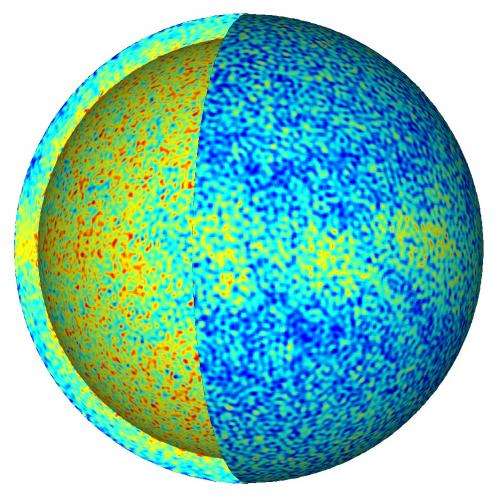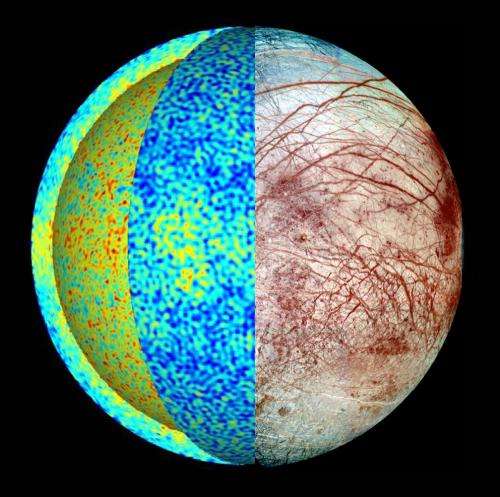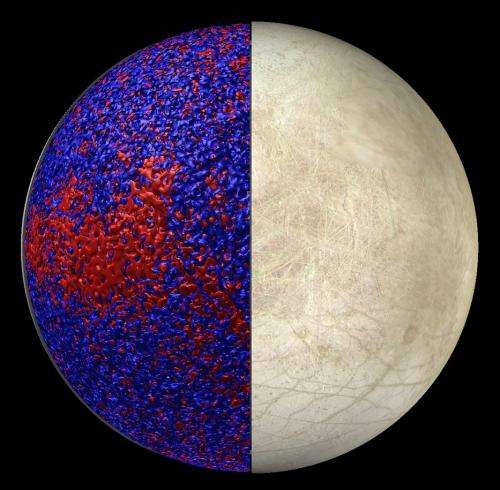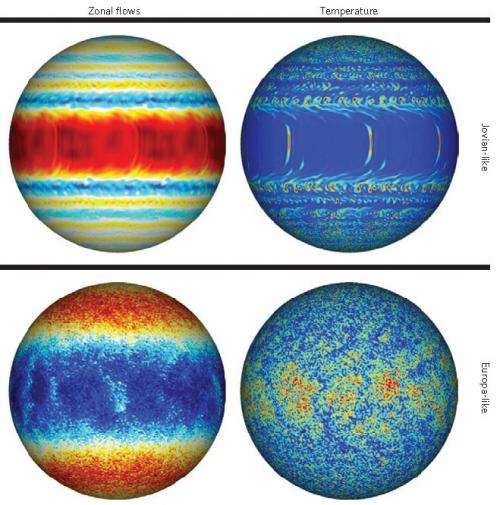December 2, 2013 report
New computer model may explain moon Europa's chaotic terrain

(Phys.org) —A team of researchers at the University of Texas with assistance from a computer modeler at the Max Planck Institute in Germany has put together a computer model that might just explain the peculiar surface of Jupiter's moon Europa. In their paper published in the journal Nature Geoscience, the team suggests the odd surface terrain patterns likely come about due to convection. Jason Goodman of Wheaton College offers a perspective on the researchers' findings in a News & Views piece printed in the same journal.
The NASA space probe Voyager flew past Jupiter and its moons in 1979, and in so doing, set off a debate about the nature of the surface of one such moon, Europa, that has continued to this day—why is the surface so smooth, and why are there odd rough patches covering nearly 40 percent of its surface? Scientists agree that the general smoothness is likely due to the existence of water beneath the icy surface—the lack of craters indicates a surface that is able to heal itself after impacts. Less of a consensus has been found regarding the rough patches, however, which scientists call "chaotic terrain." In this new study, the researchers used data from hydro-systems here on Earth as well as data from both Voyager and the Galileo spacecraft (which detected a magnetic field) to create what they believe is a reasonable model of a convection process working beneath the icy shell of Europa's surface.
Some have suggested Europa's surface gets its unique features due to the pull of gravity from Jupiter—others have suggested the sun plays a role. Such theories have not held much weight however, as there is little evidence to suggest that either could account for the chaotic terrain. Instead, the modelers suggest, it's due to convection driven by heat from the interior of the moon itself. Their model shows, they write that currents beneath the ice tend to deliver heat primarily to the equatorial regions of the surface which in turn causes constant heating, melting and refreezing—resulting they say, in the chaotic terrain that we are able to observe.

Of course, the model is based on theory, which suggests, Goodman notes, that it could be either right or wrong, and we aren't likely to know which it is until we send a probe to Europa to study its surface first-hand.


More information: Ocean-driven heating of Europa's icy shell at low latitudes, Nature Geoscience (2013) DOI: 10.1038/ngeo2021
Abstract
The ice shell of Jupiter's moon Europa is marked by regions of disrupted ice known as chaos terrains that cover up to 40% of the satellite's surface, most commonly occurring within 40° of the equator1. Concurrence with salt deposits2 implies a coupling between the geologically active ice shell and the underlying liquid water ocean at lower latitudes. Europa's ocean dynamics have been assumed to adopt a two-dimensional pattern3, 4, 5, 6, 7, 8, which channels the moon's internal heat to higher latitudes. Here we present a numerical model of thermal convection in a thin, rotating spherical shell where small-scale convection instead adopts a three-dimensional structure and is more vigorous at lower latitudes. Global-scale currents are organized into three zonal jets and two equatorial Hadley-like circulation cells. We find that these convective motions transmit Europa's internal heat towards the surface most effectively in equatorial regions, where they can directly influence the thermo-compositional state and structure of the ice shell. We suggest that such heterogeneous heating promotes the formation of chaos features through increased melting of the ice shell and subsequent deposition of marine ice at low latitudes. We conclude that Europa's ocean dynamics can modulate the exchange of heat and materials between the surface and interior and explain the observed distribution of chaos terrains.
Journal information: Nature Geoscience
© 2013 Phys.org





















